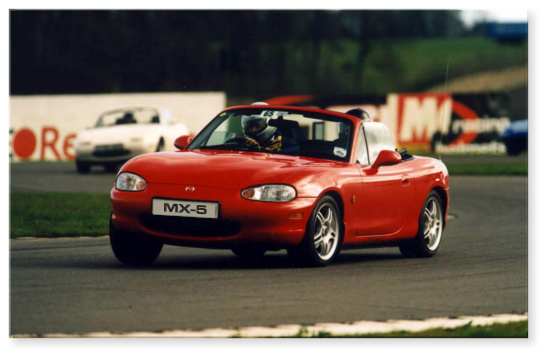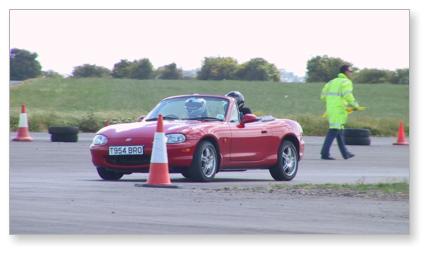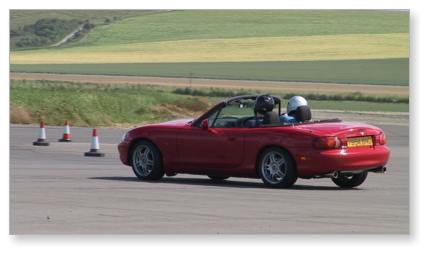

 |
 |
Introduction
I haven't done many track days, so I'm not writing this as an expert - instead, I hope to offer
all the information that I feel is useful to a beginner. I hope it's not too inaccurate!
Until you do one, the thought of a track day can be quite intimidating. Take my precious car out on a track and smash it to bits? Are you mad?!
 But track days are not like that at all. They are actually very safe events. Generally there are a few
harmless spins, and occasionally somebody over-enthusiastic damages their car, but if you drive
sensibly, it is very unlikely that you will damage your car or yourself at a track day.
A track day allows you to explore the handling of your car in ideal conditions:
But track days are not like that at all. They are actually very safe events. Generally there are a few
harmless spins, and occasionally somebody over-enthusiastic damages their car, but if you drive
sensibly, it is very unlikely that you will damage your car or yourself at a track day.
A track day allows you to explore the handling of your car in ideal conditions:
 | A wide smooth road, with no bumps, potholes, broken glass or oil spills on it |
 | No traffic coming the other way |
 | No children, horses, stupid motorists, tractors or trees leaping out at you |
 | A small number of corners that you learn and gradually (& safely) take faster |
 | The other drivers are a lot more sensible, predictable, and skilled than average road users |
 | Others are driving their own cars too, a great incentive to drive carefully! |
 | Competitive or dangerous driving is illegal. Other cars may only pass you if you indicate that you are aware of them and ready for them to pass, so it is very rare for any sort of collision between cars to occur. |
 | If something goes wrong, there's plenty of tarmac, safety gravel, and empty space to skid into, so damaging your car or yourself is unlikely. Marshals immediately wave flags to warn other drivers to slow down and take care |
 | If you are scared of a spinning and hitting another car (or another spinning and hitting you) remember that in a spin, a car will head straight off the racing line, so usually a skid or spin will take the car away from other cars on the track, naturally avoiding a collision situation |
 | In the unlikely event that something goes really wrong, you're wearing extra safety gear (helmets), and there are trained professionals including fire marshals and ambulance crews on standby to give immediate assistance - unlike on the open road! |
How are track days run?
Today we are going to talk about Dedicated Circuits and Airfield days, completely ignoring a mass of other fun
motorsport activities (open days, action days, hillclimbs, sprints, etc).
 | Dedicated circuits (Silverstone, Brands Hatch, Donington, etc) are the more expensive option, but you get to drive the tracks used by real racing drivers (as seen on TV!). |
 | Airfields are cheaper (but that in no way means they are any less challenging or rewarding). Airfield courses are large expanses of flat tarmac on which a course is laid out using cones or other markings. |
The full track day normally starts about 8:30am with a quick registration process where you sign an indemnity form that basically holds you responsible for your own actions, and get a pass (such as a coloured wrist band) that will let you onto the track. You only need to be over 18 and hold a valid UK driving licence. A short briefing is then given to inform everyone of the rules in force for the day, and you may well be given a map of the track (important as most tracks include several different circuit routes!) The organisers may then take you on a slow "formation lap" or two to familiarise all drivers with the track layout for the day.
Typical rules for a track day are as follows. These are designed to maximise everyone's safety, and anyone
breaking the rules will be (at the least) warned and may well be told to leave the circuit (no refunds!) if
their transgression is at all dangerous.
 | Always obey the marshals |
 | No inconsiderate, reckless, or dangerous driving |
 | Competitive driving is not allowed. You shouldn't "race" other drivers, and you are not allowed to time your laps. |
 | Overtaking can only be done on the straights, and you must wait for the car ahead to pull aside and indicate that they are ready for you to pass. |
 | Marshals will wave flags to communicate with you. The flags include Blue (allow those behind to pass), Yellow (danger ahead, drive slowly and carefully), Red (session stopped - all cars return slowly to pits), and Black (there is a problem with your car or your driving - return to the pits) |
 | Some venues will not allow you on track if your car is too noisy - but the allowed limits are usually pretty loud! If in doubt, ask to organisers for details. |
Typically the day is split into 20-minute sessions, and the cars are split into 3 groups so that each hour, you spend 20 minutes driving the track, and 40 minutes allowing things to cool off. Anything more than 20 minutes and you may start to overheat brakes and tyres, and may be getting tired and beginning to dehydrate, so this "short" time works very well. This scheme means that even when 60 cars are registered, you only have to share the track with about 20 of them.
An alternative arrangement is an "open pit lane". In this scheme, a fixed number of cars (e.g. 10 or 15) are allowed out on the track at a time. You queue in the pits and a marshal will let you out when a space is available. You will drive for a reasonable "session" (15-20 minutes) and then voluntarily return to the pits to allow someone else a turn. You can stay out longer but it really is best for you and your car to return to cool off, and everyone else will appreciate (and return) your cooperation! This system works very well.
Other cars
I strongly recommend starting with a track day made up of similar cars to your own (such as an MX5 club day).
Mixing it with massive Porsches, Japanese turbo saloons, and the small and nippy Caterhams may sound exciting
but watching your mirrors continuously makes concentrating on driving the track a lot more difficult, and
having to keep out of their way means you don't get much of a chance to drive the track properly.
In comparison, a bunch of MX5s will be fairly evenly matched around the track, allowing you to concentrate
more on your own driving.
Following a car of similar performance to your own is also very instructive - you can often learn as much from a bad driver's mistakes as from a good driver's lines, too. Often you can keep up with a faster driver when you are following him, as you can use his lines and braking points to go faster than you would when you have to judge these things for yourself. But be careful - if he is a lot better than you, or if he has a modified car, he may be able to go around corners at speeds you can't match! Never go faster than you feel comfortable with!
MX5 club days also have a more friendly feeling of cameraderie - there are more people around with MX5 knowledge, suitable tools, and even parts should you have a problem, and you are more likely to be able to hitch a passenger ride with a club member than a complete stranger - Do this if you possibly can, because you can learn a lot as a passenger that you can't as a driver (e.g. you can more carefully watch exactly where the other driver brakes, changes gear and accelerates - difficult if you are concentrating on driving yourself!) It's also great fun - but pick another driver who you feel safe with!
Of course, after a few track days, you might find it more interesting to drive with some faster cars and avoid being held up so much by slower drivers in cars of similar performance to your own.
Wet and Dry
Having to drive at speed in the wet can be quite a worrying concept. The main thing to remember is that you
are not racing, so as long as you treat a wet track with care and respect, there is no reason to fear
it any more than a dry track - in fact, the wet can be a lot of fun, and it's much easier on tyres
and brakes than a dry track.
The biggest problems I have found in the wet are that heavy rain can seriously reduce visibility at speed, and with the hood up, my helmet bangs annoyingly against the roof frame on every corner! If the rain gets too heavy, then I just head back to the pits to avoid too much headbanging and the risk of aquaplaning on a puddle. But generally a bit of wet track is fun and adds variety (and more experience under different conditions) to a track day. I find skiddy wet tarmac a bit scary, but remember that learning how to control your car in skids is a lot safer at 30mph in the wet than at 100mph in the dry!).
Equipment and clothing
You (and any passenger) will be required to wear a helmet while on the track - either open-faced helmets or
full-face ones are fine. If you can't borrow one, many venues/operators can rent you a helmet (if pre-booked)
- usually this is something like £10 a day. Alternatively you can buy one.
New helmets start at around £50, and can be found at any motorcycle shop - When buying a helmet, try it on for a few minutes to get used to it. Make sure it feels snug but with no uncomfortable pressure spots on your forehead, cheeks, etc. Shake your head left and right gently - the helmet should stay reasonably well attached to your face rather than spinning around! Try on as many helmets as you can (even expensive ones you know you won't buy) to get a feel for the differences in size and shape that are available. The main thing is to protect your head from impact and shrapnel in a collision - any road-legal helmet should do this so long as it is a good fit. More expensive helmets may be slightly lighter, and offer "advantages" such as better vents and aerodynamics that really don't apply so much when worn in a car for only 20 minutes at a time. If you wear glasses then make sure you include them in your tests!
Note that if you are over about 5'10" tall, you may well bang your helmet on the roof of the car. I have to drive with my top down or I bash the roof frame chronically, which really breaks my concentration (and isn't too good for my neck, roof, and helmet!). For this reason I pray for it not to rain during my sessions - although raining beforehand to provide a wet track is fine!
(A word of warning: You will find it difficult to hear the engine with a helmet on. You may be forced to fit a performance exhaust system in order to be able to hear it properly. Don't fight the temptation!)
You should wear sensible clothing - comfortable shoes (e.g trainers/sneakers), and trousers and shirt that cover your arms and legs (a sensible precaution in the unlikely event of a fire).
 Consumables and Wear
Consumables and Wear
Wear on the car at the track is normally reported to be up to 10 times that of normal driving - depending
of course on how hard you push - and during a track day you will cover anything from about 70 miles
(for slow, 2nd and 3rd gear courses) to 130 miles (on faster 3rd & 4th gear courses). You can expect to
get about a third to a half your normal fuel economy (I typically get 32mpg, but get between 11 and
15 miles per gallon on track). A normal day usually requires about 3/4 of a tank of petrol, so if you
fill up just before reaching the track you shouldn't need to refill during the day. (Note that petrol
is often available at the circuit, but will be extremely expensive there)
If you squeal and shred your tyres all day, you can go through a set in 2 track days. But if you try to drive more smoothly and work on your technique rather than thrashing around the track trying to look racy, even with soft tyres (like Bridgestone SO2s) you should be able to get away with about 1mm of wear (10%-15% of tyre life) or less. Harder tyres (such as Yokohama A509, Pirelli P6000) seem to last very well at track days.
Much the same applies to brakes - note that a good driving technique will gain far more time on the track than just braking as late and hard as possible - so if you drive sensibly and try to learn good technique, you will be much kinder to your brakes, safer (as last-minute braking leaves no room for error), and very probably be able to go faster around the circuit as well. Brake wear can be anything from 10% to 35% of the pad depth for the day. (My first set of pads lasted 16,000 miles on the road plus 160 miles (2 days) on track)
Personal considerations
Don't neglect your own needs too - take a big bottle of water and make sure you drink plenty throughout
the day. You may find you feel more comfortable eating snacks between sessions rather than one big lunch,
especially if you're a bit nervous on your first day! Most venues have on-site cafeterias, or you can nip
out to the local village for food between sessions or at lunchtime.
You may also find you get quite tired. Slow, sharp corners put you under quite a lot of sideways G-force and so you will find yourself sliding about in your seat and "hanging on" around the corners. By the end of the day, you might have some quite tired muscles - At Donington I found the left-hand Goddards hairpin made my left arm and shoulder quite tired by the end of the day. At Silverstone, my lower back started to ache in the Luffields complex. And at Wroughton, the extremely tight and slow hairpin had both my arms crossed over at full stretch, and my shoulders ached the next day.
A special reminder: If, like me, you travel at 6:30am to a track day with the top down and the heater on to keep away the early morning chill, remember to turn it off! On one summer track day I sweated all day, never having time while on track to notice that the heater was still on! I spotted it in the final 20 minute session, and had one lovely cool session to end my day! D'oh! :-)
Costs
You usually pay for the car including 1 driver - between about £70 (airfields) and £150 (premium circuits).
An extra driver usually costs more. Passengers can sometimes ride free, but usually cost £10-£25 each
(for insurance reasons, the organisers will charge you for each passenger, even though you can only take
one out at a time). Some circuits (like Silverstone) will not allow passengers. No circuits will allow
back-seat passengers (not a problem for those of us without back seats!)
You can sometimes hire helmets (perhaps £10 for the day), and you may be able to book instruction (which I heartily recommend - I got a tremendous amount out of only 6 laps with an instructor) - the more you ask for the more it costs (anything from nothing right up to perhaps £150 for a full day of instruction - again depending a lot on the circuit and organisers)
Some insurance companies (like AON) will cover you on track days for free (typically raising your excess while on track to about £1000 (or less once you have track-day experience). But lets face it, if you do any damage on the track it's likely to be a few hundred pounds of body panel (not worth claiming and losing your No Claims Discount) or (very very rarely) a massive amount of damage where £1000 will be a trivial loss in comparison!). If you can't get cover on your existing policy, then you can get single-day specialist insurance for around £30-£70 (depending on age, experience, etc)
Preparation - before the day
 | Check your brakes and tyres to make sure they have plenty of wear left in them. e.g. More than 50% brake pad left, and at least 3mm more than the legal minimum tyre tread depth on all tyres. |
 | Check fluid levels in your car (water, oil, brake fluid, power steering fluid, windscreen washer, etc) |
 | Clean all your windows |
 | Make sure you have towing hooks on the front and rear of the car so that you can be easily and quickly towed out of any gravel traps you decide to park in (these are fitted as standard, so you should be fine so long as nobody has removed them) |
 | You may also like to have your car serviced prior to a track day to allow it to run with nice clean oil, and get to the track confident that all the major components are in good repair. |
 | Over-inflate your tyres by about 5 psi (I do this before leaving home in the morning, but it can be done at a garage near the circuit, or bring a pump along and do it in the pits). This reduces the amount the tyres deform under load, which improves your cornering ability (at the expense of ride comfort), protects the side-walls from being badly scrubbed, and reduces the risk of the tyre popping off the rim entirely. 26psi is a normal tyre pressure for on-road use, but I inflate my tyres to 31-32psi when cold. Once warmed up on track, the heat increases the pressure up to around 36-38psi. Take a tyre pressure gauge with you and make sure your pressures are even, and that they don't exceed about 40 psi when you come off the track with hot tyres |
 | You can remove things like the spare tyre to save weight, but this won't make a huge difference, and will alter the car's handling slightly (less weight over the back wheels will lead to less grip at the back), which might not really do you any good. Leave that sort of performance enhancing move to the Formula 1 boys, and just go out and have fun - good driving will shave a lot more time off your laps at first than the minimal extra weight of a tyre. |
 | Remove any loose items that might fly around in the cockpit and boot. |
 Driving procedure
Driving procedure
If running fixed sessions, your session will be called to queue at the end of the pit lane as the previous session
comes to a close. If running an "open" pit, then you can join the queue whenever you feel you are ready to
go out again (and you have allowed your car to cool down and others to have a fair turn). When it is safe,
a marshal will wave the cars out one by one - you will probably have to show your pass, and may have to
wait for a bit to give the car in front a bit of space, or until it is safe to join the track.
When your turn arrives, drive carefully onto the track, and take the first lap of each session gently to allow the engine, tyres, and brakes to warm up before you try to push them hard. In your first sessions, try to watch where other cars drive and brake to get an idea of lines, but if they seem to be getting away, don't push yourself to keep up! Take things at your own pace... but...
Watch your mirrors! While cornering, concentrate on where you are going, but as you enter each straight (even very short ones) check to see if anyone is behind you - if there is someone reasonably close, then indicate and pull over to the assigned "passing" side of the track to allow the car behind to pass. Lift off the accelerator, as even very much faster drivers may not be in a car very much faster than yours, so even if they can easily out-drive you in the corners, they may not be able to breeze past you on the straights. Once they are safely past, check your mirrors and acccelerate back onto the racing line.
If you catch a slower car, then don't tailgate, and don't try to barge past. It should pull over and wave/indicate you past pretty soon. If after a while it does not, marshals may well wave a blue flag at it to remind it. If this fails you can relax and follow it to see if you can learn anything from the way it is driven (better or worse lines etc), or you can move to a clear passing position on the track, and maybe even try flashing your lights as a reminder, or you can slow down for a lap to get some space to go at your own speed again. In an open pit session you might like to just return to the pits early to ditch the slow car. Whichever option you choose, don't get angry with the other driver. Chances are they're not deliberately trying to annoy you, and they may not realise how much they were holding you up. If the driver has frustrated you a lot and not taken any hints, then do not confront them in the pits - go and talk to the organiser about it, and they will deal with things in an appropriate manner.
Take special care to try to note the positions of marshals and warning lights, and check them as you pass (this can be difficult when you are concentrating, but try to remember to look up from the onrushing track whenever you are safely heading in a straight line!), and obey the flags! When any flag is shown to you, slow down immediately and wave to the marshal so he knows you have seen him.
When the chequered flag comes out to end your session, drive one more slow lap, minimising braking, to allow your tyres and brakes to cool off, then pull into the pits. Don't try to get in one last "hot" lap. Don't drive past the chequered flag more than once. Once in the pits, stop and turn off your engine, and put the car in gear to stop it rolling away - don't engage the handbrake, as this clamps the super hot brake pads to the super hot discs, and as things cool this may cause the discs to be warped!
Take a look at your tyres to see what you've done to the poor things! And check out how black your wheels are with brake dust! (caution: contents may be hot! :-)
Driving hints
There are a lot of good resources for information on how to drive the track well. Check out
the driving hints on CircuitDriver.com and
Driving Techniques for example.
I would offer the following hints:
 | Never underestimate car-racing computer games. Especially with a steering wheel, the better of these can be quite realistic, and you can learn a lot about racing lines and steering into skids from these games. But don't drive your car immediately after a hard session in Colin McRae Rally, or there could be tears... :-) |
 | Drive slowly at the start of the day - you'll have had plenty of track time by the end of the day, and it's awful to push too hard and potentially put your car out of action on the first lap! While someone is being recovered from a gravel pit, the session will be stopped, and nobody will get any track time. |
 | Master good driving technique before you try to squeeze the last drop of speed out of the car - Whenever you are pushing at the very limit of cornering or braking speed, you have no margin for error. You will reduce your lap times more by driving smoothly on a good racing line than by trying to brake later and get into each corner "faster" - in fact, cornering is often about going slowly into the corner in order to position yourself so that you can accelerate out of it earlier and faster. Read up on racing technique, and try to practise it. Not only will you go faster, but it'll be much easier on your brakes and tyres too! |
 | Don't brake and turn simultaneously. At the end of the straight, smoothly ease on the brakes, ease off the brakes, and then turn in - this keeps the car stable and safe. I try to take this further - Only do one thing at a time: As you approach the corner, brake (and release), then change gear, then smoothly turn in, wait till you reach the apex, then ease in the acceleration. Then change up. At present (as I learn to drive on track) I believe this really helps me to drive better, as I only have to do one thing at a time, which means I can concentrate on doing each thing as well as I possibly can. As I improve I will be able to string things together to trim more time off, but to me the most important things are to drive safely and to learn to drive well. |
 | If you skid, try to steer into it to control it. If you lose control, then it is usually best to jam your foot hard on the brakes and stamp on the clutch. This (a) stops you as fast as possible, and (b) means you will skid in a straight line so you and other drivers can predict (if not control!) where you are going to go. If you release the brakes, your tyres may reassert their grip and the car will shoot off in an unpredictable direction. |
 | Try (carefully) to follow good drivers, and/or hitch passenger rides with them - you can learn a lot from them. |
 | Above all, go at your own pace. Don't feel pressured by other drivers (just slow down and let them pass - and don't try chase them recklessly), and have fun! |
Jason Williams, July 2001
If you have any comments about this site, please email us. Our operators are standing by.
 |